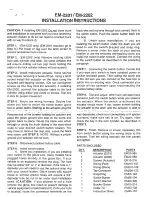
Bumps or bulges in the tread or
side of the tire. Replace the tire if
you find either of these conditions.
Cuts, splits, or cracks in the side
of the tire. Replace the tire if you
can see fabric or cord.
Excessive tread wear.
Your tires have wear indicators
molded into the tread. When the
tread wears down, you will see a 1/2
inch (12.7 mm) wide band across the
tread. This shows there is less than
1/16 inch (1.6 mm) of tread left on
the tire.
A tire this worn gives very little
traction on wet roads. You should
replace the tire if you can see three
or more tread wear indicators.
The following chart shows the
recommended cold tire pressures for
most normal and high-speed driving
conditions.
Every time you check inflation, you
should also examine the tires for
damage, foreign objects, and wear.
You should look for:
The compact spare tire pressure is:
For convenience, the recommended
cold air pressures and tire sizes are
on a label on the driver’s doorjamb.
For additional information about
your tires, see
page
.
208
Tire Size
Cold Tire Pressure
Tire Size
Cold Tire Pressure
Tire Inspection
Recommended Tire Pressures
Tires
162
INDICATOR LOCATION MARKS
TREAD WEAR INDICATORS
Front:
Rear:
60 psi (420 kPa , 4.2 kgf/cm )
215/45R17 87W
32 psi (220 kPa , 2.2
kgf/cm )
32 psi (220 kPa , 2.2
kgf/cm )
245/40R17 91W
05/08/29 18:12:12 31S2A660 0165
Main Menu
Table of Contents
▲
▼
















































